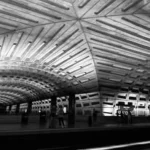
The Washington Metropolitan Area Transit Authority (WMATA) maintains 98 Metrorail stations—102, accounting for the upper and lower platforms at transfer stations—and 128 miles of track that spans 3 jurisdictions: DC, Maryland, and Virginia.
Surf the Metro and this blog, Washington, DC via Metrorail, were born from a love for Metro, and an interest in public transportation as it pertains to equitable and livable city design.
From two transit nerds living in DC on a quest to visit all 98 stations in the system, enjoy a catalogue and review of Metro-accessible eats, sights, and experiences in the nation’s capital, as well as all things Metro.
BEFORE Washington, DC via Metrorail or Surf the Metro existed, we had decided—after meeting each other only a month earlier—that one of the first things we wanted to do upon moving across the country to a whole new city… was to ride the entire Washington Metro system.
On September 22nd 2024, we created the account @surf.the.metro on Instagram and posted our first official station—Tenleytown-AU. We had already been to plenty of stations, but had gone separately and/or had no proof of those visits. For record-keeping purposes, the two of us agreed to a couple of general parameters for the run, and a set of criteria that determined whether or not a station counted towards the total:
- We begin officially counting as of 09/22/2024.
- Both of us must be present at the station together.
- We must take a photograph at the station that includes the two of us, and the station name sign on—or across the tracks—from the platform.
- We will use 102 as the total number, requiring us to count the upper and lower platforms at transfer stations seperately.
- We must leave the station to do something non-Metro related (exceptions: certain activities within stations may count at our discretion, i.e. changing lines at DC core transfer stations qualifies as a “special activity,” thus allowing us to count the upper and lower platforms without ever leaving the station).
All of the rules above ensure we keep consistent records of our progress and give each station (and the surrounding area) its due. After all, the purpose of traveling the whole system was not just to say we’d done it, but to experience the city by way of public transit.

via Foggy Bottom-GWU Station

via Capitol South Station

via Smithsonian Station
Metro is your best friend in the District. The DC Metrorail system is the second busiest in the United States, moving approximately half a million people a day around the capital city’s metropolitan area.
Where Metrorail does not run, a Metrobus almost certainly does, and with traffic congestion and nightmare parking it’s often faster, easier, and sometimes cheaper to reach your destination via public transportation—especially for visitors. WMATA’s is also one of the simplest systems to learn.
Admittedly, being transit nerds, Metro is partially to credit in our decisions to do our four years of undergrad in DC. Reliable transit ranked high among quality of life amenities we both desired—and of course—having other things to do than coursework and other places to be than campus.
As college students, WMATA’s U-Pass program gives us unlimited access to the system (for a flat fee tacked onto our cost of attendance at university), and we have been rightfully taking complete advantage of the opportunity to get around.

Harry Weese’s iconic brutalist design for Washington’s Metro has become a hallmark of the capital city’s unique look and feel, but the the vaulted waffle ceilings, red hexagonal tiles, and indirect lighting of the system are only half the charm of riding Metrorail.
Surf the Metro observes the many oddities of the system with humor, and out of good-natured curiosity. From a single shoe and someone’s toothbrush to entire novels laying on the tracks, our “Spotted on the Platform” mini series captures all the peculiar items we see while waiting for a train.

[ L’Enfant Plaza Station ]
Strange occurrences and sights included, Metro is a DC experience, and our name honors that belief.
Surfing the Metro: Successfully (and nonchalantly) standing hands-free in a railcar while the train is in motion—including on approach and departure from the platform, and during abrupt, unannounced tunnel stops.
We coined the term after spending time on one too many crowded trains where that characteristic wide stance, with your knees slightly bent to anticipate changes in speed, saved us from accidentally brushing hands with a stranger or falling into a crowd of other passengers. The action itself reminded us of surfing.
If you’ve ever been on the red line between Dupont Circle and NoMa-Gallaudet U during rush hour, you’ve likely had to surf the Metro… crammed in a packed train, trying desperately not to fly into someone’s lap when the operator hits the breaks.
In keeping with references to the system for the project, we drew the name for this blog, Washington, DC via Metrorail, from official Metro signage.

[ NoMa-Gallaudet U Station ]
Metro’s inconsistent effort of adding “via___” to the signage displaying the terminus station served by trains on either side of the platform offered an opportunity for a clever name.
With particular inspiration from the signs at NoMa, the name “Washington, DC via Metrorail” lent itself perfectly in adapting this blog’s theme to Metro’s official style guide and wayfinding conventions—Helvetica typeface and all.
As we familiarize ourselves with the national capital area through public transportation, we are more than exited to share our thoughts, experiences, and commentary as we do so. Washington, DC via Metrorail covers both Metro-accessible DC (+ Maryland & Virginia), and the nerdy details of the system that gets you where you need to be.


